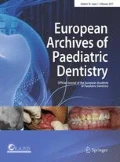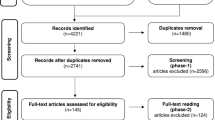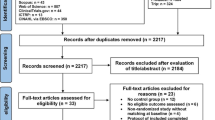Abstract
AIMS: These were to 1) estimate the prevalence of subjective symptoms and clinical signs of temporomandibular disorders (TMD) in children and adolescents in the city of JÖnkÖping, Sweden, 2) follow possible variations in TMD signs and symptoms over a 20-year period, and 3) study possible associations between TMD symptoms and signs and factors of interest. DESIGN: About 100 individuals in the age groups of 3, 5, 10 and 15 years participated in cross-sectional stratified epidemiological investigations in 1983, 1993 and 2003. METHODS: All participants were asked to fill in a questionnaire including questions on general and oral health, dental care habits and some sociodemographic issues. More specific questions recorded the presence or absence of subjective symptoms: tiredness in the jaws on awakening or during chewing; clicking sounds or crepitations from the temporomandibular joints (TMJs); locking/catching of the mandible; luxation of the mandible; reduced jaw movement capacity; pain during jaw movements; other pain conditions in the jaws or in the TMJ regions. Subjects were examined clinically at each time period for; jaw mobility (maximum jaw opening including vertical overbite, maximum laterotrusion to the right and to the left, maximum protrusion); TMJ function (normal function, deflection on jaw opening of > 2 mm, TMJ clicking or crepitations, TMJ locking, TMJ luxation); pain on jaw movement (no pain on movements, pain on one movement, pain on more than one movement); muscle pain (no muscle pain, pain on palpation in 1–3 sites, pain on palpation in > 3 sites); TMJ pain (no joint pain, pain on lateral palpation of one or both joints, pain on posterior palpation of one or both joints). No functional examination of the masticatory system was performed in children aged 3 and 5 years. RESULTS: TMD-related symptoms were very rare in 3- and 5-year-olds. In the age groups of 10- and 15-year-olds, 5–9% of the participants reported more severe symptoms, up to 50% showed one or more TMD signs, while it was estimated that 1–2% were in need of TMD treatment. Several symptoms and signs increased with age. No gender differences, with the exception of recurrent headache, were noted. Oral parafunctions were reported by 11–47%. Apart from a few variables, no statistically significant changes in the prevalence of TMD symptoms and signs were observed over the 20-year period. Clenching/grinding of teeth and general health factors were found to be associated with TMD symptoms and signs. CONCLUSIONS: The prevalence of more severe TMD symptoms and signs in children and adolescents was generally low in all three examinations and did not change significantly during the 20-year period. Increasing age, general health factors and oral parafunctions were associated with TMD symptoms and signs in 10- and 15-year-olds.
Similar content being viewed by others
References
Abdel-Hakim AM, Alsalem A, Khan N. Stomatognathic dysfunctional symptoms in Saudi Arabian adolescents. J Oral Rehabil. 1996;23:655–661.
American Academy of Orofacial Pain: Differential diagnosis and management considerations of temporomandibular disorders; in Okeson JP (ed): Orofacial Pain: Guidelines for Assessment, Diagnosis, and Management. Quintessence Publishing Co Inc1996, pp 113–184.
Bakke M, Hoyer I, Skaaning H, Moller E. Screening of functional malformations of the TMJ, headaches and facial pain. A part of the OCR-registration (Swedish). Tandlaegernes Tidsskr. 1990;5:60–62.
Brattberg G. Do pain problems in young school children persist into early adulthood? A 13-year follow-up. Eur J Pain. 2004;8:187–199.
Brun Sundblad GM, Saartok T, Engstrom LM. Prevalence and co-occurrence of self-rated pain and perceived health in school-children: Age and gender differences. Eur J Pain. 2007;11:171–180.
Carlsson GE, Egermark-Eriksson I, Magnusson T. Intra- and inter-observer variation in functional examination of the masticatory system. Swed Dent J. 1980;4:187–194.
Castelo PM, Gaviao MB, Pereira LJ, Bonjardim LR. Relationship between oral parafunctional/nutritive sucking habits and temporomandibular joint dysfunction in primary dentition. Int J Paediatr Dent. 2005;15:29–36.
Farsi NM. Symptoms and signs of temporomandibular disorders and oral parafunctions among Saudi children. J Oral Rehabil. 2003;30:1200–08.
Feteih RM. Signs and symptoms of temporomandibular disorders and oral parafunctions in urban Saudi Arabian adolescents: a research report. Head Face Med. 2006;2:25.
Fischer DJ, Mueller BA, Critchlow CW, LeResche L. The association of temporomandibular disorder pain with history of head and neck injury in adolescents. J Orofac Pain. 2006;20:191–198.
Gaffney A. Cognitive developmental aspects of pain in school-age children. In: Schechter NL, Berde CB, Yaster M (eds). Pain in Infants, Children, and Adolescents. Hong Kong: William & Wilkins Baltimore, 1993:75–85.
Heikinheimo K, Salmi K, Myllarniemi S, Kirveskari P. Symptoms of craniomandibular disorder in a sample of Finnish adolescents at the ages of 12 and 15 years. Eur J Orthod. 1989;11:325–331.
Helkimo M. Studies on function and dysfunction of the masticatory system. II. Index for anamnestic and clinical dysfunction and occlusal state. Sven Tandlak Tidskr. 1974;67:101–121.
Hirsch C, Sehrer G. TMD in children and adolescents: a review of the current literature. In: John M, Hirsch C, Seligman DA, Reiber Th (eds). Epidemiological research on temporomandibular disorders. International workshop on epidemiology and etiology of temporomandibular disorders (Leipzig, May 22–23, 1998). Regensburg: S. Roderer Verlag, 2000: 81–95.
Hirsch C, John MT, Schaller HG, Turp JC. Pain-related impairment and health care utilization in children and adolescents: a comparison of orofacial pain with abdominal pain, back pain, and headache. Quintessence Int. 2006a;37:381–390.
Hirsch C, John MT, Lautenschlager C, List T. Mandibular jaw movement capacity in 10–17-yr-old children and adolescents: normative values and the influence of gender, age, and temporomandibular disorders. Eur J Oral Sci. 2006b;114:465–470.
Hugoson A, Koch G, Gothberg C, et al. Oral health of individuals aged 3–80 years in Jonkoping, Sweden during 30 years (1973-2003). I. Review of findings on dental care habits and knowledge of oral health. Swed Dent J. 2005;29:125–138.
Hugoson A, Koch G, Helkimo AN, Lundin SA. Caries prevalence and distribution in individuals aged 3–20 years in Jonkoping, Sweden, over a 30-year period (1973-2003). Int J Paediatr Dent. 2008;18:18–26.
Kononen M, Nystrom M, Kleemola-Kujala E, et al. Signs and symptoms of craniomandibular disorders in a series of Finnish children. Acta Odontol Scand. 1987; 45:109–114.
Kononen M, Nystrom M. A longitudinal study of craniomandibular disorders in Finnish adolescents. J Orofac Pain. 1993;7:329–336.
Kopp S, Wenneberg B. Intra- and interobserver variability in the assessment of signs of disorder in the stomatognathic system. Swed Dent J. 1983;7:239–246.
Laurell K, Larsson B, Eeg-Olofsson O. Prevalence of headache in Swedish schoolchildren, with a focus on tension-type headache. Cephalalgia. 2004;24:380–388.
LeResche L, Mancl LA, Drangsholt MT, Saunders K, Korff MV. Relationship of pain and symptoms to pubertal development in adolescents. Pain. 2005;118:201–209.
Liljeström MR. Temporomandibular disorders and headache in adolescents [thesis]. Turku, Finland: Annales Universitatis Turkuensis D 778; 2007.
Magnusson T, Egermark-Eriksson I, Carlsson GE. Four-year longitudinal study of mandibular dysfunction in children. Community Dent Oral Epidemiol. 1985;13:117–120.
Magnusson T. Five-year longitudinal study of signs and symptoms of mandibular dysfunction in adolescents. J Craniomandib Pract. 1986;4:338–344.
Magnusson T, Egermark I, Carlsson GE. A longitudinal epidemiologic study of signs and symptoms of temporomandibular disorders from 15 to 35 years of age. J Orofac Pain. 2000;14:310–319.
Magnusson T, Helkimo M. Temporomandibular disorders in children and adolescents. In: Koch G, Poulsen S (eds). Pediatric dentistry — a clinical approach. Copenhagen: Munksgaard, 2001: 411–420.
Nilner M. Epidemiology of functional disturbances and diseases in the stomatognathic system. A cross-sectional study of 7–18 year olds from an urban district [thesis]. Swed Dent J. 1983; Suppl 17.
Nilner M. Functional disturbances and diseases in the stomatognathic system among 7- to 18-year-olds. J Craniomandib Pract. 1985;3:358–367.
Nilsson IM. Reliability, validity, incidence and impact of temporomandibular pain disorders in adolescents [thesis]. Swed Dent J. 2007; Suppl 183.
Nydell A, Helkimo M, Koch G. Craniomandibular disorders in children-a critical review of the literature. Swed Dent J. 1994;18:191–205.
Thilander B, Rubio G, Pena L, de Mayorga C. Prevalence of temporomandibular dysfunction and its association with malocclusion in children and adolescents: an epidemiologic study related to specified stages of dental development. Angle Orthod. 2002;72:146–154.
Vanderas AP. Prevalence of craniomandibular dysfunction in children and adolescents: a review. Pediatr Dent. 1987;9:312–316.
Wahlund K. Temporomandibular disorders in adolescents. Epidemiological and methodological studies and a randomized controlled trial [thesis]. Swed Dent J. 2003; Suppl. 164.
Wanman A. Craniomandibular disorders in adolescents. A longitudinal study in an urban Swedish population (thesis). Swed Dent J. 1987; Suppl 44.
Wanman A, Agerberg G. Recurrent headaches and craniomandibular disorders in adolescents: a longitudinal study. J Craniomandib Disord Facial Oral Pain. 1987;1:229–236.
Wanman A. Longitudinal course of symptoms of craniomandibular disorders in men and women. A 10-year follow-up study of an epidemiologic sample. Acta Odontol Scand. 1996;54:337–342.
Widmalm SE, Christiansen RL, Gunn SM, Hawley LM. Prevalence of signs and symptoms of craniomandibular disorders and orofacial parafunction in 4–6-year-old African-American and Caucasian children. J Oral Rehabil. 1995a;22:87–93.
Widmalm SE, Christiansen RL, Gunn SM. Oral parafunctions as temporomandibular disorder risk factors in children. J Craniomandib Pract. 1995b;13:242–246.
Author information
Authors and Affiliations
Corresponding author
Rights and permissions
About this article
Cite this article
KÖhler, A.A., Nydell Helkimo, A., Magnusson, T. et al. Prevalence of symptoms and signs indicative of temporomandibular disorders in children and adolescents. A cross-sectional epidemiological investigation covering two decades. Eur Arch Paediatr Dent 10 (Suppl 1), 16–25 (2009). https://doi.org/10.1007/BF03262695
Published:
Issue Date:
DOI: https://doi.org/10.1007/BF03262695




